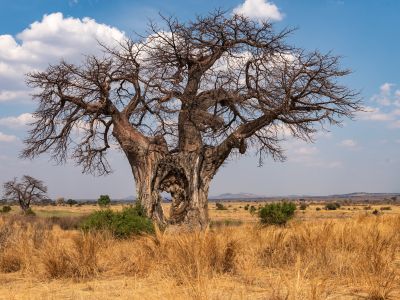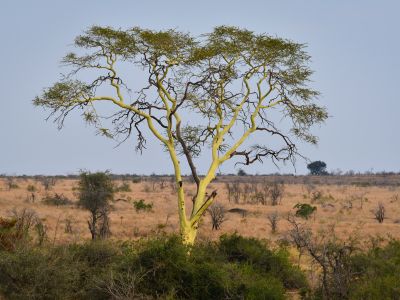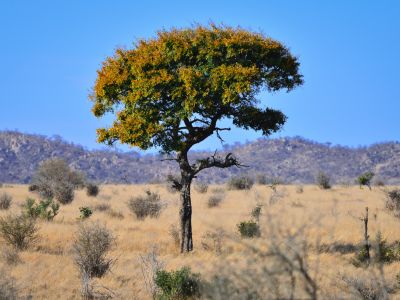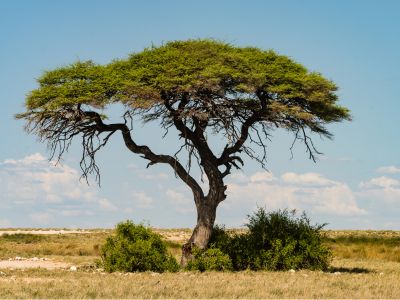Introduction
Welcome to Kruger National Park, Africa’s largest and South Africa’s oldest wildlife reserve. Beyond its iconic wildlife, this vast expanse of over 2 million hectares is also home to some of the most impressive trees in the bushveld.
Among these giants are the iconic Baobab, the striking Fever Tree, the resilient Knob Thorn, the fruit-bearing Marula, and the hardy Mopane. These Big Five Trees stand as silent sentinels of the park’s rich ecosystem. Join us as we explore these towering natural wonders, each offering its own unique beauty and significance in the heart of Kruger.
Baobab

The baobab, often referred to as the “Tree of Life,” is one of Africa’s most iconic and revered trees. Towering majestically with its thick, trunk and sprawling branches, the baobab is instantly recognisable and holds a special place in the heart of the African landscape. These ancient giants can live for thousands of years, storing vast amounts of water in their trunks to survive the harsh, dry seasons. Their resilience and longevity have made them symbols of strength and endurance, while their unique, almost otherworldly appearance has inspired countless legends and folklore.
Beyond their impressive stature, baobabs play a crucial role in their ecosystems. Their hollow trunks provide shelter for animals, and their nutrient-rich fruit, known as monkey bread, is a valuable food source for both wildlife and humans. The baobab’s leaves and bark are used in traditional medicine, and its presence supports a myriad of life forms, from the smallest insects to large mammals. In many African cultures, baobabs are considered sacred, and their protection is deeply ingrained in local traditions. As a keystone species, the baobab is vital to the health and stability of its environment, making it a true natural wonder of the African continent.
Fever Tree

The fever tree, with its striking, pale green bark that almost glows in the African sunlight, is one of the most visually captivating trees in the savannah. This tree, often found near water sources like rivers and wetlands, plays a crucial role in its ecosystem. Its scientific name, Vachellia xanthophloea, hints at its unique appearance, with “xanthophloea” meaning “yellow bark” in Greek. The fever tree is not only a visual delight but also a lifeline for many species, providing essential shade and habitat for birds and insects.
Historically, the fever tree got its name from early European settlers who associated it with malaria, as they often found it growing in malarial swamps. However, the tree itself does not cause fever; it was the mosquitoes breeding in the swampy areas that were the real culprits. Despite this misconception, the fever tree remains a vital part of the landscape. Its nitrogen-fixing abilities enrich the soil, fostering a healthier environment for other plants and animals. This tree’s beauty and ecological importance make it a treasured sight in the African wilderness.
Knob thorn

The Knob Thorn tree, scientifically known as Vachellia nigrescens, is a distinctive feature of the African savannah, easily recognisable by its impressive thorns that resemble small knobs or spikes. These thorns are more than just a defence mechanism; they help the tree withstand the harsh conditions of its environment, from intense sun to grazing animals. During the dry season, the Knob Thorn’s resilient branches provide much-needed shade and shelter for various wildlife, creating a haven in the arid landscape.
Beyond its striking appearance, the Knob Thorn plays a crucial role in the ecosystem. Its leaves are a vital food source for herbivores like giraffes and elephants, who use their long necks and trunks to reach the nutritious foliage. Additionally, the tree’s flowers attract a range of pollinators, including bees and butterflies, contributing to the biodiversity of the savannah. With its robust presence and ecological contributions, the Knob Thorn tree is a true cornerstone of the African bush.
Marula

The Marula tree (Sclerocarya birrea) is a true gem of the African landscape, known for its distinctive, spreading canopy and vibrant green leaves. This tree is celebrated not only for its striking appearance but also for its delicious fruits, which turn a brilliant yellow when ripe. These fruits are a favourite among many animals, from elephants and monkeys to birds, making the Marula a vital food source in the wild. The fruit’s tangy, refreshing flavour is also cherished by local communities, who use it to make a variety of traditional beverages and culinary delights.
Beyond its role as a food source, the Marula tree has significant cultural and ecological importance. Its dense shade offers a respite from the harsh sun, creating a cool retreat for both wildlife and humans. The tree’s bark and leaves are used in traditional medicine, showcasing its versatility. Additionally, Marula trees contribute to the savannah’s ecological balance by providing habitat and sustenance for various species, ensuring its place as a cherished symbol of African biodiversity.
Mopane

The Mopane tree (Colophospermum mopane) is a quintessential feature of Africa’s arid landscapes, renowned for its distinctive, butterfly-shaped leaves that turn a striking orange or red during the dry season. This hardy tree thrives in the harsh conditions of the savannah and provides a vital resource for numerous animals. Elephants, in particular, are fond of its nutritious leaves and bark, making the Mopane an essential part of their diet. The tree’s ability to withstand drought and poor soils underscores its resilience and adaptability to the African climate.
In addition to its ecological importance, the Mopane tree plays a crucial role in local cultures. Its leaves are used in traditional practices, and the tree’s wood is valued for making durable tools and furniture. The Mopane also supports a variety of wildlife, from insects to birds, enhancing the biodiversity of its habitat. Its unique appearance and functional benefits make the Mopane tree a true emblem of the African bush, blending beauty with practicality in the region’s challenging environment.
Conclusion
As we wrap up our journey through Africa’s Big 5 trees, it is clear that these giants are more than just part of the landscape—they are the lifeblood of their ecosystems. Each tree, from the majestic Baobab to the vibrant Fever Tree, plays a unique role in supporting wildlife and sustaining the environment. Their distinctive features and functions not only add beauty to the African bush but also provide essential resources for countless species, creating a dynamic web of life.
The Baobab, with its enormous trunk and ancient presence, stands as a symbol of endurance and vitality. The Fever Tree’s striking yellow bark and medicinal qualities reveal its vital contribution to both the landscape and local health. The Knob Thorn’s resilience and the Marula’s delicious fruit show how these trees adapt and thrive in the face of challenges, while the Mopane’s distinctive leaves and practical uses highlight its importance in the ecosystem.
Celebrating these iconic trees reminds us of the intricate connections within nature and the need to preserve these natural treasures. As we admire the grandeur and utility of Africa’s Big 5 trees, we gain a deeper appreciation for the delicate balance that sustains life in the African bush. These trees are not just landmarks but integral components of a thriving ecosystem, deserving our respect and conservation efforts.